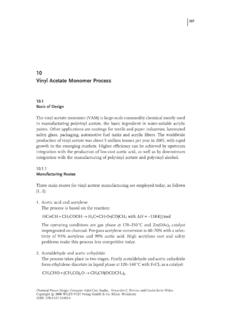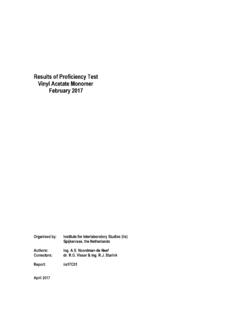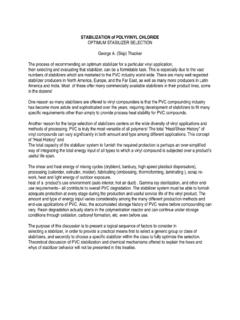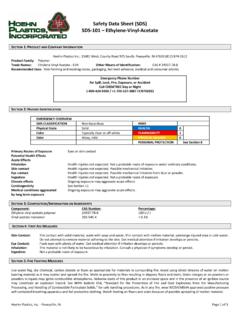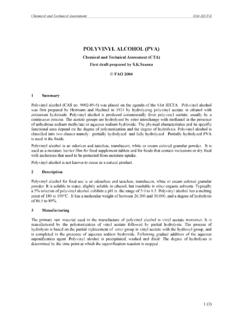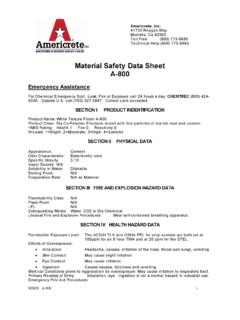Transcription of Vazo - Miller-Stephenson Chemical
1 Product Information f . Vazo . free radical sources Properties, Uses, Storage, and Handling Introduction Applications Vazo free radical sources (FRSs) provide efficient Acrylic and Other vinyl initiation of many Chemical reactions, including: Polymerizations acrylic and vinyl polymerizations Vazo 52, 64, 67, and 88 are used primarily in halogenations bulk, solution, and suspension polymerizations and oxidations and related chain reactions copolymerizations and to a lesser extent in emul- sion Common acrylic and vinyl additions of small molecules across olefinic monomers polymerized with Vazo FRSs are: double bonds vinyl chloride cross-linking acrylonitrile Vazo FRSs are white solids, which are soluble in acrylic acid a wide variety of solvents. Thermal decomposition to two free radicals per Vazo FRS molecule is acrylamide strictly first order and is, therefore, controlled by styrene regulating temperature.
2 Unlike peroxide initiators, ethylene the rate of decomposition of a Vazo FRS is not vinyl acetate dependent on the solvent or monomer in which it is dissolved or on the presence of soluble metal ions. vinylidene chloride Also, there is no evidence of induced chain decom- methyl methacrylate This absence of induced decomposition methyl acrylate results in the improved efficiency of Vazo FRS in unsaturated polyesters polymerizations2 and other reactions. The reactivity of each grade of Vazo FRS is Ordering Information described by its grade number, which is the tem- To order DuPont Vazo free radical sources prod- perature in C at which the half-life in solution uct or literature from within the United States, call is 10 hr. DuPont Specialty Chemicals at (800) 441-9340. For locations outside the United States, contact the local DuPont representative in your country.
3 You may also reach us by filling out the feedback form on our internet web site, vazo/. Vazo is a registered trademark of DuPont. Nonpolymerization Uses Vazo 64 [2,2 -azobis(2-methylpropanenitrile) or Vazo FRSs initiate the addition of compounds 2,2 -azobis(isobutyronitrile) also known as AIBN]: such as chlorine, hydrogen sulfide, thiols, and This grade is more cost-effective than any organic phosphines, across double bonds. peroxide of comparable activity. (See Health Hazards with regard to the toxicity of its main Vazo FRSs react with unsaturated compounds in decomposition product, tetramethylsuccinonitrile equimolar amounts to give monomers and oligo- [TMSN].). mers, which contain two Vazo FRS-derived groups. These dinitriles can be further converted to CH3 CH3. amides, amines, or acids. CH3 C N N C CH3. Vazo FRSs initiate halogenations as well as the air oxidation of aromatic and aliphatic hydrocarbons, CN CN.
4 Acrylonitrile, methyl methacrylate, and vinyl acetate. Vazo 67 [2,2 -azobis(2-methylbutanenitrile) or 2,2 -azobis(methylbutyronitrile)]: This grade has the best solubility in organic solvents and mono- Grades and Chemical Structures mers. It does not generate highly toxic TMSN as Vazo 52 [2,2 -azobis(2,4-dimethylpentanenitrile) Vazo 64 does. or 2,2 -azobis(2,4-dimethylvaleronitrile)]: This grade is used for low-temperature polymerizations. CH3 CH3. CH2 CH3 C N N C CH2 CH3. CH3 CH3. CN CN. (CH3)2 CHCH2CH2 C N N C CH2CH2CH(CH3)2. CN CN Vazo 88 [1,1 -azobis(cyclohexanecarbonitrile) or 1,1 -azobis(cyanocyclohexane)]: This grade is used for high-temperature polymerizations. CH2 CH2 N N CH2 CH2. H2C C C CH2. CH2 CH2 CN NC CH2 CH2. Properties The physical properties of the four grades are shown in Table 1. 2. Table 1.
5 Properties of DuPont Vazo Free Radical Sourcesa Vazo 52 Vazo 64 Vazo 67 Vazo 88. Molecular formula C14H24N4 C8H12N4 C10H16N4 C14H20N4. Molecular weight CAS number 4419-11-8 78-67-1 13472-08-7 2094-98-6. Form Noodles Noodles Noodles Noodles Color White White White White Bulk density, approx., lb/ft3 26 31 15 18 26 31 25 28. kg/m3 416 496 240 288 416 496 400 450. Specific gravity . Specific heat,b cal/g C ~ ~ ~ ~ kJ/kg K ~ ~ ~ ~ Heat of combustion,c kcal/g mol 1208 . kJ/kg mol . denotes not determined . a Typical properties are based on historical production performance. DuPont does not make any express or implied warranty that these products will continue to have these typical properties. DuPont test methods are available on request. b Calculated c Calculated, s H O (liq.) + CO + N . 2 2 2. Isomers Solubility The trans-isomers predominate.
6 Whereas Vazo 64 Vazo 52, 64, 67, and 88 are essentially insoluble and Vazo 88 each are single compounds, which in water, sparingly soluble in aliphatic hydrocar- melt slightly above 100 C (212 F) and 115 C bons, and soluble in functionalized organic com- (239 F), respectively, Vazo 52 can be readily pounds and aromatic hydrocarbons. Vazo 67 has separated into components melting at 56 57 C the highest solubility in organic solvents. Solubility (133 135 F) and 75 76 C (167 169 F). One of data are shown in Table 2. these is a meso-form and the other a dextro-levo pair. Because the latter has not been resolved, it is not possible to relate structure to melting point. Vazo 67 must also exist in two forms, but they have not been separated; the mixture melts at about 49 C (120 F). 3. Decomposition The dimer formed from Vazo 64 (TMSN) is Differential thermal analyses show exotherms toxic (see section on Health Hazards).
7 Beginning at 55 C (131 F) for Vazo 52 and 106 C. (223 F) for Vazo 64. Both analyses were done on Flammability the dry solids. Vazo 52, 64, 67, and 88 are flammable solids, In solution, Vazo FRSs decompose on heating, which can be ignited with an open flame or a liberating nitrogen and forming two free continuous electric arc. Once a fire starts, combus- For Vazo 64, the reaction is: tion is bright and complete, as long as an adequate supply of air is available. CH3 CH3 CH3. The autoignition temperatures are 225 C (437 F). CH3 C N N C CH3 N2 + CH3 C for Vazo 52, 295 C (563 F) for Vazo 64, 185 C. CN CN CN. (365 F) for Vazo 67, and 290 C (554 F) for Vazo 88, as measured by the spinning-disc Because the decomposition is first-order,1 the rate method. of free-radical formation is controlled by regulating the temperature.
8 The half-lives for the four Vazo . grades as a function of temperature are shown in Photochemical Stability Figure 1. The rates of decomposition are essen- The photochemical decomposition of Vazo 64. tially independent of solvent type and the presence (AIBN) to initiate polymerization has been re- of metal ions. The decomposition of each grade has Vazo 52, 64, 67, and 88 absorb at 350. an activation energy of approximately 31 kcal/mol nm. (130 kJ/mol). Ideally, all the radicals formed from the decomposi- Advantages of Vazo FRSs tion of Vazo FRSs initiate the desired reaction. Vazo FRSs have many significant advantages No initiator, however, is 100% effective. Some versus other initiators: radicals react with each other, even in the presence Unlike organic peroxides, Vazo FRSs are not of excess monomer. The extent of this side reaction shock-sensitive.
9 Varies substantially, depending on reaction condi- tions. In the absence of monomer, all of the radi- Vazo FRSs can be stored and handled at more cals react with each other. The dimer is formed in convenient temperatures than many peroxides the highest concentration with lesser amounts of with similar half-lives. the ketenimine and other by-products formed Vazo FRSs are more cost-effective versus other through disproportionation. The ketenimine will initiators. Free radicals generated from Vazo . undergo rearrangement to TMSN. Under acidic FRSs are generally less energetic than those from conditions, the ketenimine will react with water to organic peroxides and persulfates. These radicals form hydrogen cyanide. produce fewer side reactions, such as hydrogen abstraction, and this results in higher efficiencies.
10 To illustrate, the reaction of radicals from Vazo Another economic advantage with Vazo 64 is its 64 in the absence of monomer is shown below: low molecular weight, which results in lower cost per pound-mole. Isobutyronitrile CH3 CH3 CH3 CH3 CH3 CH3 CH2. CH3C H3C C C CH3 + H3C C = C = N C CH3 + H3C CH + H3C C. CN CN CN CN CN CN. Tetramethylsuccinonitrile (TMSN) Ketenimine Methacrylonitrile 4. Table 2. Solubilities of Vazo Polymerization Initiators, g/100 g Solvent Vazo 52 Vazo 64 Vazo 67 Vazo 88. at 0 C at 25 C at 0 C at 25 C at 25 C at 25 C. Solvent (32 F) (77 F) (32 F) (77 F) (77 F) (77 F). Acetone 39 75 12 29 >185 30. Acrylonitrile 20 38 Benzene 49 108 <1 11 Butyl cellosolve 2 . Carbon tetrachloride Chloroform 54 100 17 25 . Chlorostyrene 13d Diallyl phthalate <7d Dibutyl phthalate 23 . Dichloromethane 40 >185 65.
